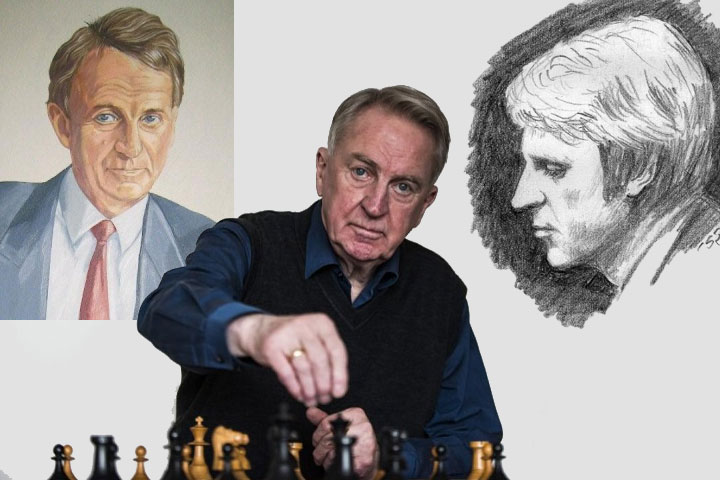This year, Iceland celebrates several prominent birthdays: Björk, the enigmatic singer and songwriter, will turn 60—time flies! Vigdis Finnbogadottir, who is considered the first woman in the world to be democratically elected as president by popular vote, will turn 95. She served as Iceland's head of state from 1980 to 1996. Fridrik Olafsson, five years younger than Vigdis, is currently the oldest living Candidate for the World Chess Championship.
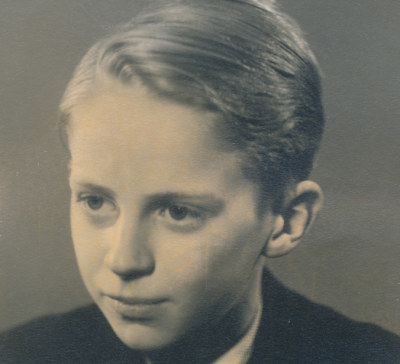
Do you recognize him? A young Fridrik in 1948 | Photo: skaksogufelagid.is
The five oldest living former Candidates are: Fridrik Olafsson, followed by Oscar Panno (born in March 1935), Boris Spassky and Lajos Portisch (both born in 1937), and Vlastimil Hort (born in 1944).
Fridrik Olafsson (or Friðrik Ólafsson in Icelandic orthography) was born on January 26, 1935, in Reykjavik, where he still resides. He became a Grandmaster in 1958 after qualifying at the Interzonal for the Candidates Tournament in 1959.
He was Iceland's strongest player for many decades and part of the world chess elite between the mid-1950s and the early 1980s, winning both major tournament series of his time: the Hastings Congress and Wijk aan Zee. Known for his entertaining and attacking style, Olafsson has defeated four World Champions in classical chess: Petrosian, Tal, Fischer, and Karpov.
Certainly one of the strongest amateur players of the modern era, Olafsson became a chess professional only briefly, during the mid-1970s. He worked as a lawyer at the Icelandic Ministry of Justice and served for more than twenty years as Secretary General of the Icelandic Parliament, the Althingi. From 1978 to 1982, Fridrik Olafsson—a man of principles—served as president of FIDE.
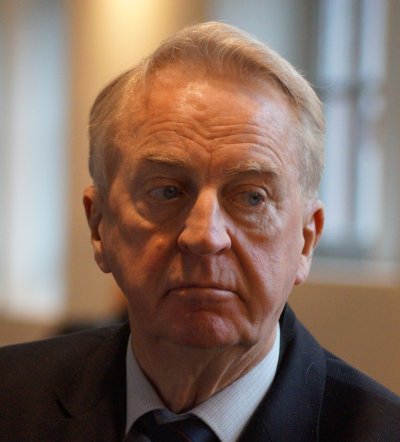
Olafsson in Berlin, 2015 | Photo: Frank Hoppe
Iconic Icelander
It was Olafsson who put Iceland on the world chess map, long before the Fischer-Spassky match was even conceived. Fridrik Olafsson was the first Grandmaster from his small nation.
Nowadays, the Nordic island boasts more than a dozen Grandmasters, despite a population of only 400,000. Iceland is the country with the most native chess Grandmasters per capita in the world.
During the occupation of Denmark in World War II, Iceland became an independent republic on June 17, 1944, ending its remaining formal ties with Denmark. You could say Olafsson is older than his own country! He learned to play chess from his father at the age of eight.
At just 17 years old, he won his first Icelandic Championship. In total, Fridrik is a six-time national champion, winning in 1952, 1953, 1957, 1961, 1962, and 1969. He is also a multiple Scandinavian Champion.
He participated in the World Junior Championships twice: in 1951, at the inaugural Juniors (won by Borislav Ivkov in a Swiss system), and two years later in the second edition, which was organized as a round robin. Oscar Panno won the gold medal in that event. Eight players competed in the final A-group in 1953, listed alphabetically:
Klaus Darga from West Germany, Borislav Ivkov from Yugoslavia, Dieter Keller from Switzerland, Bent Larsen from Denmark, Fridrik Olafsson from Iceland, Oscar Panno from Argentina, Jonathan Penrose from England, and James Sherwin from the USA.
Five of these players are still alive: Olafsson, Panno, Darga (who shared first place with Panno but only earned silver due to inferior tie-breaks—no Magnus/Nepo agreements in those days!), Sherwin, and Dieter Keller, who inflicted the only loss on the eventual winner, Panno, during the preliminaries.
Olafsson completed his studies in law and took a position at the Icelandic Ministry of Justice. He continued to be a part-time chess player for the next 25 years and would have undoubtedly achieved even greater success if he had been able to devote all his energies to chess.
Today, he has retired from practicing law and lives in his native country, which in 1972 hosted what is perhaps the most famous chess match ever held: the World Chess Championship between Boris Spassky and Bobby Fischer. Olafsson contributed significantly to the organization of this legendary event in Reykjavik.
Becoming an International Master in 1956
Untitled at the time, Olafsson gained international recognition by tying Viktor Korchnoi for first place in the top group at the Hastings Winter Congress 1955/56. Both players finished undefeated, ahead of Borislav Ivkov in clear third, followed by Mark Taimanov in fourth, and reigning West German Champion Klaus Darga in fifth.
After that tournament win, IM Korchnoi was awarded the GM title by FIDE, and Olafsson received the IM title. Ivkov and Taimanov were already Grandmasters—remember, there were fewer than 50 living chess Grandmasters at that time!
IM and GM norms did not exist in the 1950s and 1960s. The IM and GM titles were primarily granted for winning an important international tournament or achieving another outstanding result.
In 1955 and 1957, Fridrik Olafsson played two friendly matches with Herman Pilnik, himself a Candidate in 1956, winning both.
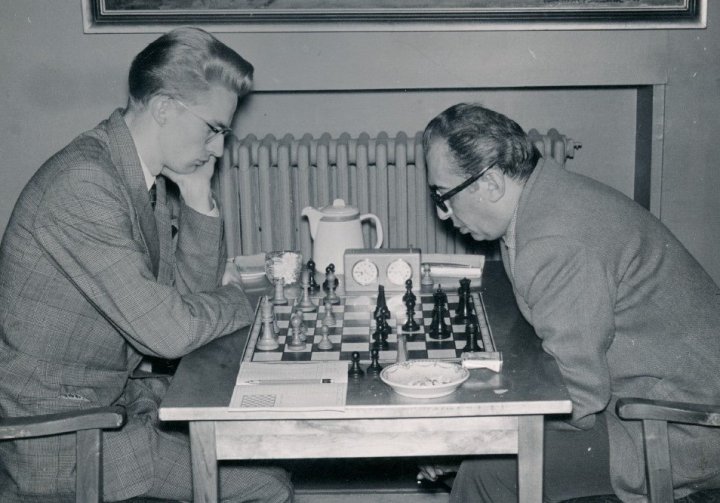
Olafsson at 20 of age, facing Grandmaster Pilnik in Reykjavik 1955 | Photo: skaksogufelagid.is
Qualifying for the Candidates as an IM in 1958
In the 1958 Interzonal tournament at Portoroz, won by the young Mikhail Tal, IM Fridrik Olafsson defeated favorites such as Averbakh, Fischer, Gligoric, Larsen, and Szabo, finishing in equal 5th-6th place with IM Bobby Fischer. Both qualified for the 1959 Candidates Tournament, the final stage to determine the challenger for the World Champion. Olafsson accomplished this feat despite not being a professional player, making him a national hero in Iceland.
Olafsson was awarded the GM title automatically after qualifying at the 1958 Interzonal for the 1959 Candidates Tournament (apparently, Olafsson had already been informed during the ongoing tournament, following a FIDE meeting, that he would be awarded the GM title regardless of the final outcome, based on his recent strong results).
In the following quadruple-round event featuring eight candidates, organized in Bled, Zagreb, and Belgrade in 1959, Fridrik Olafsson scored wins against Fischer, Petrosian (defeating him in their individual mini-match twice, with one draw and one loss), Keres, Gligoric, and Benko. However, Fridrik ultimately finished in seventh place, suffering too many losses due to his lively and uncompromising playing style.
In a meteoric rise, the young Tal also won the Candidates Tournament, finishing ahead of Keres, who once again had the misfortune of taking second place. Tal went on to dethrone Botvinnik in 1960.
Olafsson proved to be Petrosian's nemesis during the tournament. Petrosian, who finished third behind Tal and Keres but ahead of Smyslov in fourth and Fischer in fifth, drew all four of his games against Tal (in 12, 23, 15, and 25 moves—their third game in round 19 lasted less than ten minutes). Petrosian also scored one win and three draws against Keres. However, his chances of greater success were compromised by Olafsson, who achieved a memorable victory in their round 15 game—a game that became an eternal highlight for Fridrik.
The game had been adjourned, and when it was resumed, a giant demonstration board had been set up, according to historian, arbiter, and English chess master Harry Golombek. A crowd of 5,000 people gathered to watch. Olafsson won the game, and when he attempted to return to his hotel, the enthusiastic crowd insisted on carrying him on their shoulders.
A brilliant win over Petrosian at the Candidate’s tournament in 1959
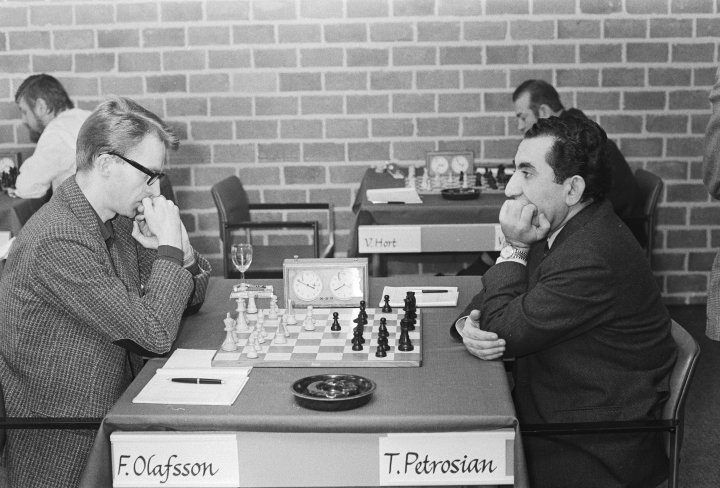
Olafsson playing Petrosian at Hoogovens Wijk aan Zee 1971. Donner (left) and Korchnoi in the background. Photo: Anefo, Rob C. Croes
Winning Both Hastings Chess Congress and Hoogovens Wijk aan Zee — and achievements in important International Tournaments
The arguably most prestigious annually recurring international chess tournament series during the second half of the 20th century were the Hastings Chess Congress, then organized as an elite closed group, and Hoogovens Wijk aan Zee, initially held in Beverwijk. There are exactly 17 “double winners,” listed alphabetically: Andersson, Bareev, Botvinnik, Euwe, Karpov, Keres, Korchnoi, Larsen, Nunn, Olafsson, Portisch, Rossolimo, Short, Spassky, Tal, Tartakower, and Timman.
Among Fridrik Olafsson’s finest international results are his co-win at the Hastings Congress 1955/56, shared with Viktor Korchnoi, and his two triumphs at the traditional Hoogovens tournament (today TATA Steel). He won at Beverwijk in 1959 as the clear first, ahead of Eliskases, and at Wijk aan Zee in 1976, shared with Ljubomir Ljubojevic, finishing above Tal and Kurajica, who shared third.
Olafsson was runner-up at Wijk aan Zee in 1971, tying with Gligoric, Ivkov, and Petrosian, and finishing ahead of Andersson, Hort, Hübner, and Mecking, who all tied for fifth. Viktor Korchnoi won outright that year.
Other notable results include:
- Third place at the Piatigorsky Cup in Los Angeles, 1963, tying with Najdorf and finishing ahead of Reshevsky, Gligoric, Benko, and Panno. (Petrosian and Keres shared first.)
- Joint second place with Beliavsky at Las Palmas, 1974, finishing ahead of Polugaevsky, Larsen, and Andersson. Ljubojevic won the tournament.
- Runner-up at Tallinn, 1975, tying with Spassky and finishing ahead of Bronstein and Hort. Keres, in the year of his passing, won the event.
Of course, Olafsson also won or co-won several strong international invitational events in Reykjavik, including notable victories in 1957, 1966, 1972, and 1976.
Individual Gold at the Chess Olympiad
In 1962, at the Chess Olympiad in Varna, Bulgaria, Fridrik Olafsson won the individual Gold medal on board one with a score of (+10 =8). In total, Olafsson represented Iceland in eight Chess Olympiads between 1952 and 1980.
After many years as one of the top non-Soviet players, Olafsson was also nominated as the first reserve in the USSR vs. Rest of the World match in 1970. He played a single game in the final round, losing to Smyslov.
Chess Is for All Ages — From Grandmaster Tartakower to Grandmaster Gunina
Fridrik Olafsson has defeated many greats in classical games, from Tartakower (*1887) at Hastings to Gunina (*1989) during a team event, "Women versus Veterans." His list of opponents includes Korchnoi, Keres, Geller, Stein, Taimanov, Averbakh, Reshevsky, Najdorf, Eliskases, Pilnik, Panno, Gligoric, Ivkov, Szabo, Portisch, Ribli, Sax, Csom, Hort, Uhlmann, Unzicker, O'Kelly de Galway, Donner, Andersson, Timman, Miles, Speelman, Byrne, Benko, Browne, Seirawan, Hübner, and of course Larsen.
Against Larsen, Olafsson played nearly 50 games over more than 50 years, maintaining a fairly even head-to-head record. Both Larsen and Olafsson were born in 1935.
Additionally, Olafsson defeated four World Champions in classical chess: Fischer (twice), Tal (twice), Petrosian (twice), and Karpov. A particularly memorable victory came at the Clarin supertournament in Buenos Aires in 1980, won by Bent Larsen. At this event, the reigning FIDE President Olafsson defeated the reigning World Champion Karpov—a remarkable achievement!
FIDE President beats World Champion
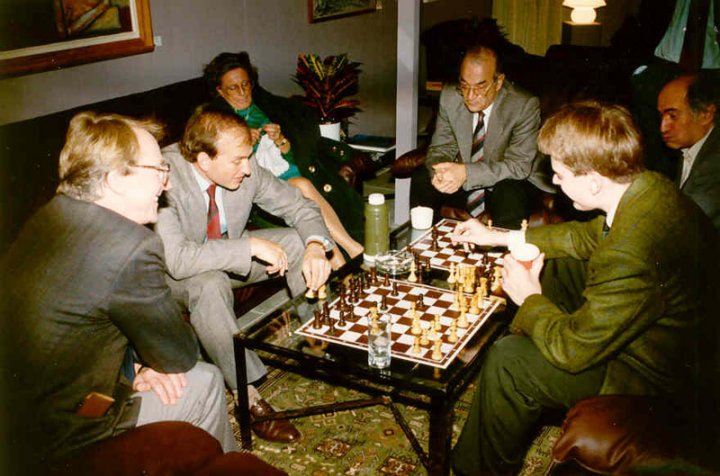
Fridrik Olafsson (non-playing), Alexander Beliavsky, Petra and Viktor Korchnoi, Mikhail Tal and Johann Hjartarson during the GMA tournament in Reykjavik 1988 | Photo: skakmyndr.com (no longer active)
Absolute World Elite
In the unofficial FIDE Elo rating from Spring 1969 (based on results from the period between January 1966 and Spring 1969, then by far the most extensive ranking list ever published by Prof. Arpad Elo), Fridrik Olafsson achieved his highest ranking. Looking back with nostalgia:
| Rank |
Player |
Elo |
Age |
| 1 |
Fischer |
2720 |
25 |
| 2 |
Spassky |
2690 |
31 |
| 3 |
Korchnoi |
2680 |
37 |
| 4 |
Botvinnik |
2660 |
57 |
| 5 |
Petrosian |
2650 |
39 |
| 6 |
Larsen |
2630 |
33 |
| 7 |
Portisch |
2620 |
31 |
| 8 |
Geller |
2620 |
43 |
| 9 |
Smyslov |
2620 |
47 |
| 10 |
Keres |
2610 |
52 |
| 11 |
Polugaevsky |
2610 |
34 |
| 12 |
Stein |
2610 |
34 |
| 13 |
Tal |
2610 |
32 |
| 14 |
Olafsson |
2600 |
33 |
| 15 |
Kholmov |
2600 |
43 |
| 16 |
Najdorf |
2590 |
58 |
| 17 |
Hort |
2590 |
24 |
| 18 |
Bronstein |
2590 |
44 |
| 19 |
Furman |
2590 |
48 |
| 20 |
Taimanov |
2590 |
42 |
| 21 |
Gligoric |
2590 |
45 |
Worth mentioning:
- 27th: Reshevsky, 2570, age 57.
Olafsson was, at that time, the strongest amateur player in the world. Six former, current, or future World Champions (Botvinnik, Smyslov, Tal, Petrosian, Spassky, and Fischer) were in the top twenty. Najdorf (*1910) and Botvinnik (*1911) were the oldest players, while Hort (*1944) and Fischer (*1943) were the youngest. In the top fifty, only one player was under twenty: IM Mecking (*1952).
Fridrik Olafsson remained a stable top twenty to fifty player from the mid-1950s to the early 1980s.
His highest historical ranking in Chessmetrics by Jeff Sonas was No. 13 at the end of 1958, behind:
- Tal
- Smyslov
- Botvinnik
- Keres
- Bronstein
- Gligoric
- Petrosian
- Korchnoi
- Geller
- Taimanov
- Spassky
- Averbakh
In other words, Olafsson was the Best in the West, behind 11 (!) Soviet players plus Gligoric from Yugoslavia. The next highest-ranked players after Olafsson were:
14. Szabo
15. Pachman
16. Najdorf
17. Benko
18. Reshevsky
19. Larsen
20. Kholmov
Worth mentioning:
24th: Young Bobby Fischer.
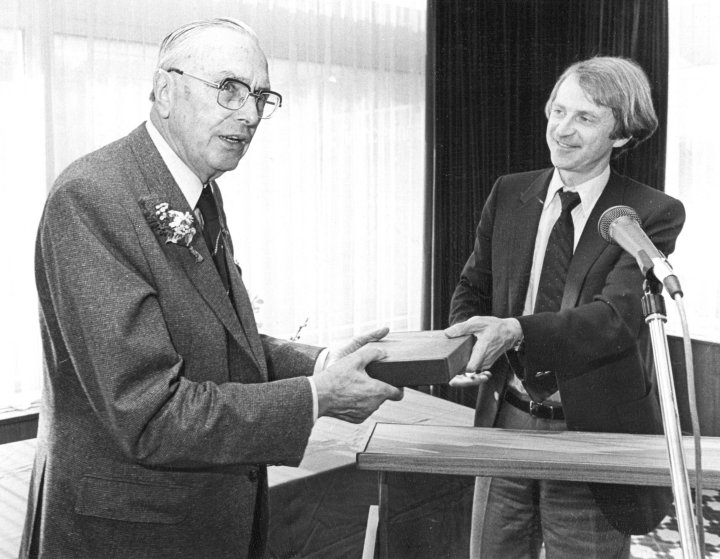
Prof. Max Euwe hands over the FIDE Presidency to Fridrik Olafsson in late 1978, Photo: Anefo
Successor of Max Euwe as FIDE President
In 1978, Max Euwe retired after eight years as FIDE President at the age of 77. Fridrik Olafsson succeeded him as the president of the international chess governing body and served in this capacity for four years.
Olafsson defeated businessman and longtime FIDE functionary Narciso Rabell Mendez from Puerto Rico in a second ballot by a decisive margin of 57 to 34 votes. The first ballot had been incredibly close: Narciso Rabell Mendez received 31 votes, Fridrik Olafsson 30 votes, and Svetozar Gligoric 29 votes.
During his tenure, Olafsson presided over the 1981 Karpov-Korchnoi World Championship match. Since Viktor Korchnoi had emigrated from the Soviet Union in 1976, the Soviets were holding Korchnoi's son Igor and his wife Bella (they were eventually released in 1982). Olafsson delayed the planned start date of the 1981 match in an attempt to secure the liberation of Viktor's son and wife. This effort, however, drew the wrath of the Soviets.
In 1982, there were again three candidates for the FIDE presidency: Fridrik Olafsson (the incumbent), Florencio Campomanes (one of the FIDE vice presidents, who had been the local organizer of the 1978 title clash between Karpov and Korchnoi), and Bozidar Kazic from Yugoslavia (a renowned arbiter and head of the Commission of the FIDE Rules of the Game).
As had happened with Gligoric four years earlier, Kazic was eliminated in the first round. The Soviet Union and its satellite states supported Campomanes from the Philippines. Olafsson lost the election in the second ballot to Campomanes. Following this, Olafsson was appointed General Secretary to the Icelandic Parliament, the Althingi.
Subsequently, he played competitive chess only rarely, apart from the famous Reykjavik Open and some Memorials or team events featuring legends and ladies.
Fridrik Olafsson has been awarded honorary citizenship of the City of Reykjavik, an honor bestowed only five times before. Throughout his career and life, he has carried the reputation of his nation across the globe.

FIDE Managing Director and WGM Dana Reizniece-Ozola, Latvia, with Fridrik in Reykjavik 2022 | Photo: FIDE Twitter (X)
Happy Birthday, good Health and Happiness, with the best wishes for Fridrik Olafsson!
Links:
Friðrik Ólafsson – Skáksögufélagið – The Icelandic Chess Heritage Society
An excellent and extensive website in honour of Fridrik Olafsson, about his career and worthy opponents, with description and database of all his games and results, a complete listing of tournament, match and team events with pictorial reports. Fantastic archival footage!
“The Chess Saga of Fridrik Olafsson”, written by Norwegian Øystein Brekke, an experienced chess player, organizer, arbiter, trainer, historian, author and publisher, and Fridrik Olafsson himself, has been released recently in english language. The book contains all important narrative and many annotated games from the life and chess career of Iceland’s first and most prominent grandmaster, with assorted photos from a romantic era.
A book review by Frederic Friedel who also presents Fridrik’s maybe craziest chess game ever: The Chess Saga of Fridrik Ólafsson | ChessBase
